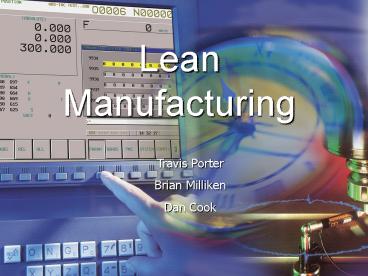Lean Manufacturing - PowerPoint PPT Presentation
1 / 21
Title:
Lean Manufacturing
Description:
ALL SYSTEMS MUST MESH TOGETHER TO BE EFFECTIVE 30 YEARS FOR TOYOTA ... KAIZEN AND 'FINDING HERBIE' PRODUCTION BOTTLENECK. DEFINE WHAT YOU- THE ORGANIZATION- AND ... – PowerPoint PPT presentation
Number of Views:531
Avg rating:3.0/5.0
Title: Lean Manufacturing
1
Lean Manufacturing
Travis Porter Brian Milliken Dan Cook
2
LEANS ORIGIN
- PIONEERED BY HENRY FORD FLOW PRODUCTION IN 1914
- TOYOTA BEGAN TESTING LEAN CONCEPTS IN THE 1940s
3
- ORDER?PRODUCTION?DELIVERY
- PRODUCT AND PROCESS DEVELOPMENT
- CUSTOMER MANAGEMENT
- SUPPLIER MANAGEMENT
- ALL SYSTEMS MUST MESH TOGETHER TO BE EFFECTIVE?30
YEARS FOR TOYOTA TO ACCOMPLISH - LEAN MANUFACTURING DIDNT CATCH ON UNTIL THE
1990s
4
Dr. Demings 14 Points for Total Quality
Management
- Create consistency of purpose for continual
improvement - Adopt the new management philosophy focused on
quality. - Eliminate the need for mass inspection by
building quality into the product - End the practice of awarding business on the
basis of price tag alone.
5
Dr. Demings 14 Points for Total Quality
Management
- Constantly improve every process for planning,
production, and service - Institute modern training methods for all to make
better use of every employee - Institute leadership aimed at helping people
perform more quality work - Drive out fear throughout the organization by
encouraging two way communication
6
Dr. Demings 14 Points for Total Quality
Management
- Break down inter-department barriers such that
departments can work in teams to tackle problems - Eliminate the use of propoganda that demands high
productivity and zero defects without providing
methods. - Eliminate work standards based on numerical
quotas.
7
Dr. Demings 14 Points for Total Quality
Management
- Remove barriers that hinder a workers right to
pride of workmanship, including the annual
performance appraisal. - Encourage self-improvement for everyone through
continued education - Define top managements permanent commitment to
the preceding 13 points.
8
DESCRIPTION
- CONCEPTS
- PUT IDEAS/INVENTION TO USE AT THE MOMENT OF
INNOVATION - VISUAL MANAGEMENT TOOLS (5S, CELLULAR
ARRANGEMENT, TARGET COSTINGECT)
9
- U-SHAPED PRODUCTION CELLS
- SMALL WORKBENCH LESS CLUTTER
- LABELS FOR FIXTURES, TOOLING RACKS, AND TOOLS
- FOLDER CONTAINING SETUP PHOTOS AND CYCLE TIMES
NEAR THE MACHINE - ON-DECK LIST-JOB FLOW
10
- HORIZONTAL MANAGEMENT-MORE PEOPLE SEE THE WASTE
- EVERYBODY KNOWS WHO IS IN CHARGE OF WHAT
- KAIZEN AND FINDING HERBIE PRODUCTION BOTTLENECK
11
DEFINE WHAT YOU-THE ORGANIZATION- AND THE
CUSTOMER WANT
- An employee should be able to walk through a
work area one time and come away with 90 of the
information about that area. Mr. Malone, RD
Manufacturing Industries
12
LEAN PRODUCTION vs. MASS PRODUCTION
- MASS-
- EXPENSIVE MACHINES DO MULTIPLE TASKS
- PEOPLE REQUIRED TO KEEP MACHINES BUSY
- BEST FOR SPECIALIZED PRODUCTS IN HIGH QUANTITIES
- LEAN-
- REMAINS FLEXIBLE
- EASIER TO ANALYZE COST
- FEW DEFECT, IMPROVED TIME, AND HIGHLY DETAILED
PARTS
13
Lean Implementation Case Study
- Boeing Machine Fabrication Business Unit (MBU)
- 1000 Different products produced
- 22,000 parts per month
- 650,000 square foot facility
- 700 employees
14
Prior to Lean
- Shop was configured in a job shop layout
- Similar machines grouped together
- Work in progress (WIP) traveled great distances
through various value adding operations. - Success measured in terms of machine efficiency,
and machine tool setup savings associated with
batching parts
15
The Lean Team
- Team of management, tooling, quality control, and
safety personnel - Told to identify waste in current process.
- Initiated Lean Manufacturing Assessment
- Analyzed total product cost, where the MBU spent
resources and what products the MBU produced
16
Four Key Areas
- The Lean Team focused on four key areas to make
the transition to lean manufacturing - Product focused cells
- Simplified scheduling system
- Improved shop floor control
- Organizational support structure
17
Product Focused Cells
- Machines were moved from the typical job shop
layout to a product based layout - Reduced travel that parts would have to make
between different processes.
18
Simplified Scheduling System
- Processes that were considered bottle necks to
the overall production process were consistently
run to produce maximum efficiency. - First in first out scheduling ensured products
would get done in a logical order (first in,
first to get done) and no products would be lost
in inventory
19
Improved Shop Floor Control
- Visual controls to replace existing information
management system. - Simplicity achieved through implementing product
focused cells so parts dont move far from their
respective cells until they are completed and
shipped out.
20
Organizational Support Structure
- Calls upon manufacturing engineers to focus more
on production cells and providing support at the
production level. - Improved customer focus and production
efficiency. - Employee education programs run regularly (5-10
times per month).
21
General Results
- Reduced total overall cost by 30.
- Productivity increased by 39.
- Defects reduced from 1200/10,000 in 1996 to fewer
than 300/10,000 today. - Money lost due to defects reduced by 51.
- Product travel reduced by 1-3 miles per part.
- Shop size reduced from 650,000 sq-ft to 450,000
sq-ft































